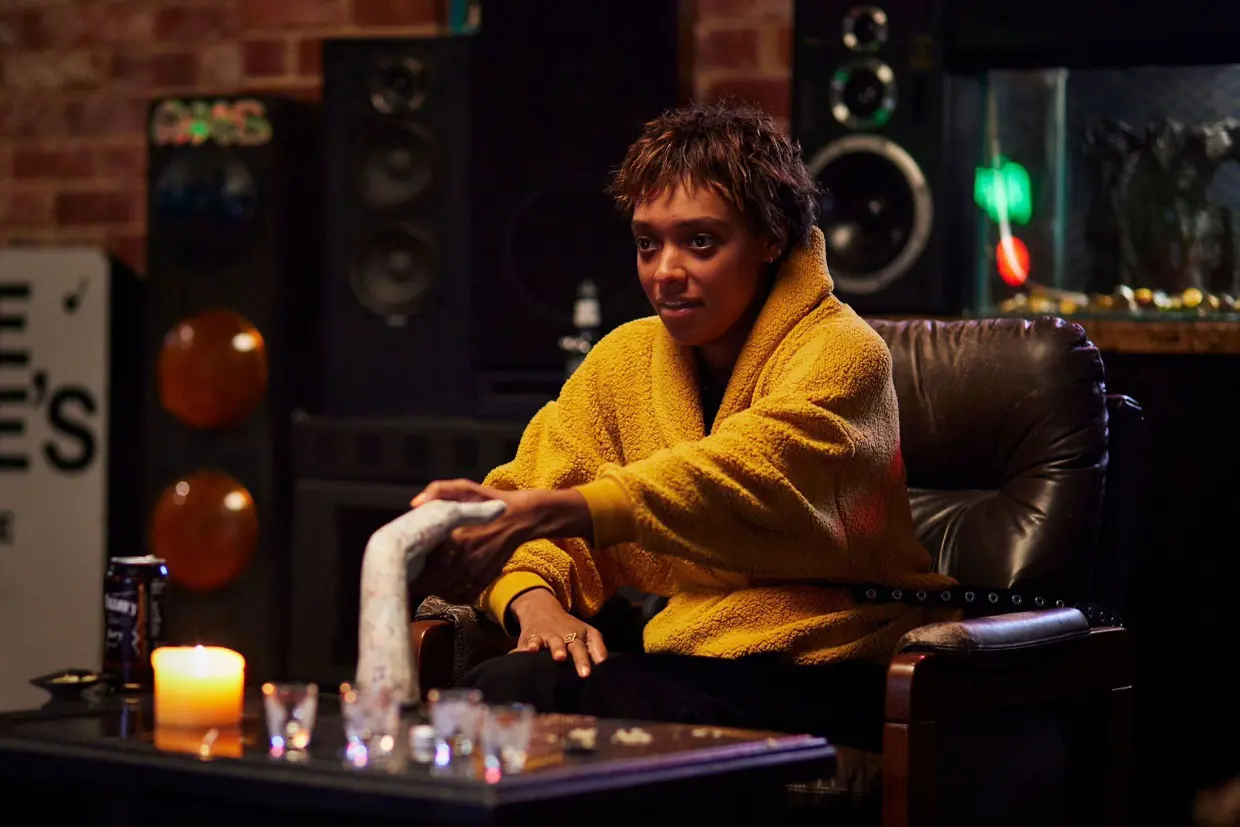DEVON THOMAS: Demons, drugs, depression: Why 'Talk to Me' is one of 2023's most cardinal films
Devon Thomas
22 October 2023 | 10:00Using a simple but effective concept of temporary possession through a game, A24's 'Talk to Me' is able to portray one of the most hauntingly nuanced depictions of mental anguish in cinema, whilst never coming across as exploitative.
OPINION
Contains spoilers for the entire film.
It’s very seldom that I find horror movies genuinely uncomfortable to watch – not because they’re bad or overly violent, but because they’re triggering.
Off the top of my head, the first movies like this that come to mind are The Texas Chainsaw Massacre (1974), Maniac (2012), Hereditary (2018), Gerald’s Game (2017), Black Swan (2010), The Shining (1980), The Menu (2022), and, to some extent, Get Out (2017).
Though these sprawl into a range of sub-genres, they all have one common thread: they, in some way or another, effectively portray what it feels like to be in anguish - be it mental, social, emotional, or physical.
Talk to Me, released in South African cinemas in September, has become the pinnacle of these types of movies, where I found myself taking mini-breaks between each subsequent viewing after the first one ruined my whole night.
Touted by some as one of the best movies of 2023 (me being one of those people), Talk to Me, plot-wise, follows a group of friends as they play a game using an embalmed hand to conjure up spirits stuck in limbo, becoming hooked to the game until things go way too far.
The Australian supernatural horror movie is an exceptional offering from A24 and directors Danny and Michael Philippou that expertly display the potential of the effectiveness of demonic possession-type movies when they’re free from the ‘based on a true story’ trope – my least favourite in all of cinema.
The problem with the trope is that not only is it frustratingly repetitive (looking at you The Conjuring Universe), but it can be extremely restrictive to the creative freedom of the story.
However, when free from the shackles of The Exorcist (1973), possession-type movies can be one of the most effective sub-genres in exploring the human psyche and the impact that some of life’s most harrowing moments could have from micro to macro level.
When done right, not many other genres are able to captivate the human experience and our fears more, using the idea of the fear of possession and expanding it to explore sub-textual themes such as grief, abuse, parenthood, mental illness, trauma, and even macro social ills such as racism, poverty, othering, and misogyny.
Though arguably far and few between, the best of these movies can terrify you at the moment and haunt you long after.
Within this zeitgeist of films, not since Hereditary has a movie like Talk to Me permeated my unconscious as effectively as it has – going to the point of falling under the list of movies I revere but will, likely, seldom rewatch.
THE PLOT
Talk to Me follows our ‘protagonist’, 17-year-old Mia (Sophie Wilde), two years after her mother died from an overdose where it’s initially unclear to the audience – and to her - if it was purposeful or an accident.
After the movie’s cold open – where it’s implied that someone stabbed his brother and then killed themselves after using ‘the hand’ – Mia drives her best friend’s younger brother, Riley (Joe Bird), home. In an excellent execution of foreshadowing, Mia sees a dying kangaroo on the road but is unable to mercy kill it despite its visible suffering.
Still struggling to cope, Mia is desperate to feel anything other than the hollow emptiness her mother’s death left, and, so, she convinces her best friend, Jade (Alexandra Jensen), to attend a house party where a group of rowdy teens are playing a game where they allegedly become temporarily possessed by a wandering spirit – all while being taped to post on social media.
At the party, Mia seems to be unwelcomed by the group at first but falls in their favour after she agrees to go first in the game.
The game is simple: a person takes hold of an embalmed hand, either decapitated from a medium or a satanist, and asks it to talk to them, which summons the spirit before them where they then tell the spirit that they “let [them] in”, becoming temporarily possessed.
It, however, has established rules: light a candle to open the door between the living and the dead, hold the hand for no longer than 90 seconds, and then blow the candle out afterwards to close the door again.
If the player does not manage to let go of the hand in time, the spirit will want to stay where if you happen to die while they’re lingering, they’ll “have you forever”.
Seems simple enough, right? Mia seems to think so.
After taking a spin at the game, the spirit lingers for a few seconds longer because they – obviously – struggled to ‘disarm’ it, but the group thinks nothing of it because it was too short to do much damage, right? Right?
Feeling exhilarated and telling Riley later that day that the hand “felt incredible”, Mia then sways Jade to host a party so that they (read: she) can play it again.
At the party, there’s an outstanding montage of everyone, except for Jade and Riley, including Jade’s boyfriend, Daniel (Otis Dhanji), taking turns using the hand that is perfectly shot, directed, and edited.
It flawlessly captures the intoxicating feeling that comes from the (recreational) use of drugs - one of the movie’s clear sub-textual themes - while also highlighting the escapism and feeling of belonging that can come with that.
For the first time in a while, Mia doesn’t feel alone and depressed, and for the first time in a while, Mia feels alive.
As you can imagine, things go left from here.
As the party begins to die down, Riley begs Jade if he can play the game, even if it's not for as long. After she, rightfully, refuses, he asks Mia who yields and says he’ll only have a go at it for 50 seconds. Riley is several years younger than them, mind you.
And so, Riley takes a go at it, seemingly becoming possessed by Mia’s mother while under the hand’s influence who tells her that she “never wanted to hurt” her and that she’s “proud” of her – just the kind of sweet nothings you’d expect a good-for-nothing imitator to say.
However, the sweet nothings work, and Mia forces the group to let Riley go over the allocated time as she clings to the presence of her ‘mother’, resulting in one of the most visceral headbangers (pun intended) I have ever seen in film.
Eventually, now passing the two-minute mark, the group is able to take the hand from Riley, whose face is now screwed but not as screwed as his soul is about to be.
Mia should’ve taken heed of the saying in Pet Semetary that “sometimes dead is better”.

Sophia Wilde as Mia in A24's 'Talk to Me' (2023). Picture: X/FilmUpdates
From here into the second act, the film devolves into a pretty standard A24 possession film: Riley does some more head banging and licks his blood at home, Mia is shunned from the only people she felt a connection towards, which leads her to use the hand more in a desperate attempt to reconnect with her ‘mother’, she sucks some toes, and can now see spirits without using the hand – just like the guy in the cold open did – and descends into madness.
However, unlike the traditional possession film, or even an A24 possession film, this only increased its grip on my throat and my psyche because the more things played out and the more intense things became in the lead to the third act, the more I came to relate to Mia’s story.
MIA'S DESCENT, MY STORY
Though I have personally never tried to contact the dead, and I am only possessed by the ‘demon of homosexuality’, I have been to places that have gone as dark as Mia’s descent.
To put it briefly, after over a year of intense shifts in my mood for periods on end, I was diagnosed with bipolar affective disorder, generalised anxiety, and ADHD in 2016. This aspiring himbo has layers lmao.
Though my diagnoses brought me some clarity, my seemingly never-ending mental health issues only got worse as years passed, and I was only able to get some semblance of a grip on it in 2022.
Because of this, compounded with the cacophony of traumas inflicted on me, I, like Mia, had been desperate for any sort of reprieve, more often than not resorting to a range of self-destructive activities to either fill the void or distract from its encompassing darkness.
Of course, my self-destructive behaviour only ‘worked’ temporarily, but the darker things got, the clearer it became that I was doing more harm to myself than good.
So, don’t get me wrong, Mia is a pretty flawed protagonist whose awful decisions are pretty much the reason that all the mess in the movie happened – but isn’t that the point?
Unlike in many horror movies where dumb decisions by characters are a sometimes-infuriating and lazy plot device to jump from point A to point T, Mia’s decisions make total sense in the vein of her character arc.
From our initial introduction to her, it’s quite clear that Mia is not in a good space and is kind of just existing – not living – so, of course, she will not be making good life choices. Yes, not everyone in a dark space makes bad decisions – and neither are her actions excusable – but when you’re in the mental pits of hell, very little of what you do will be entirely sensible or logical to someone ‘normal’.
At least, this was the case for me where every bad decision made sense to me because everything else around me felt like it didn’t.
I have (luckily) been able to time and time again ‘make it to the other side of the tunnel’, but it is entirely understandable, from that perspective, why Mia was doing what she was doing. Though Mia’s decisions kept getting worse, to her, at least, it felt like she was doing the right thing.
Perhaps the most effective way Talk to Me shows this is how Mia reacts to Riley’s ‘condition’. After finding out more about the events of the cold open, Mia, Jade, Daniel and co. are told that if they find a way to wait it out, eventually the spirit possessing Riley will weaken and leave.
However, now arguably ‘addicted’ to the hand, Mia convinces Jade and Daniel that they could try using the hand to free Riley. Though clearly a terrible idea from an outside perspective, Mia rationalises it by theorising that because they possibly did not blow the candle out, they did not close the door between the living and the dead.
So, at the hospital, they initially tried using Riley’s – who is unconscious at this point – hand to shut the door, which obviously did not work. Mia, then, suggests she use the hand to speak to Riley due to the potential that he could now also be in limbo. What this would accomplish is unclear but, again, to Mia, it makes sense so that she can use the hand ‘one last time’.
In a turn of events, after Mia uses the hand, she sees the spirit of a little girl and asks her if she knows where Riley is. In response, the girl says she can “take [her] to him” and lets Mia in. Once let in, Mia sees a truly haunting image of Riley being violently tormented by a group of spirits and, for the first time, frantically lets go of the hand. To make matters worse, when Mia gets home her father confesses that her mother did, indeed, kill herself, and reads her suicide note to her.
Having now fallen completely into a pit of agony compounded with the guilt of her decisions now that she is ‘sober’, Mia’s fraud mother is able to convince her that the only way to save Riley is for her to “put him out of her misery” because the spirits will “never let him go”.
After fraud promises to “look after” Riley on the other side, Mia, fresh from stabbing her dad in the neck because the spirits tricked her into thinking he was trying to kill her, tells Jade to come to her place to distract her enough to, essentially, mercy kill Riley.
In a callback to the Kangaroo scene and despite her mother’s continued sweet nothings, Mia is unable to stab Riley to death.
Not the quitter, however, Mia’s mother eventually convinces her to kill Riley by throwing him into oncoming traffic while he is comatose in a wheelchair. How this is easier than stabbing him is unclear.
Feeding into what is clearly now a metaphoric depiction of complete psychosis, Mia’s mother reiterates how “proud” of her she is, that she can “protect” Riley, and, most importantly, that she’s “doing the right thing”.
This is where things are left to interpretation because there is no clear indication as to what happens, but Mia lets go of the wheelchair – suggesting that she would, again, have been unable to put mercy kill him. Jade, then, seemingly pushes Mia into the highway’s oncoming traffic instead. It can then be assumed that Mia died because no one around her reacted to her. This extends to a truly depressing scene where she walks along the hospital corridors and sees everyone she loves, but, again, no one reacts to her, and she does not have a reflection.
She runs after her father, desperate to get his attention, and he enters the hospital’s elevator, which, once closed, envelopes her in complete darkness, begging her “not to leave”. Thereafter, she sees a candle in the distance, walks towards it, sees a hand extended to her, and is told that he lets her in. The score while all of this is happening hits hard.
And that’s the end of Talk to Me, girlies. Don’t we love a happy ending?
To me, at least, Talk to Me is a hauntingly effective depiction of the pitfalls of depression, grief, drug abuse, and mental anguish.
Though the people around her were heavily affected by her decisions, I think it is important to note that, in the end, Mia’s darkness only consumed her - that’s why Talk to Me never comes across as exploitative. In my experience, mental illness, even at its worst, has a grave effect on the people around the person but no one suffers more than the person afflicted.
Though some (read: me) have been able to make it to the other side (relatively) much better than before, not all of us will be so lucky.
If you’re wondering, I’d give it 9.5 admissions to rehab out of 10.
Get the whole picture 💡
Take a look at the topic timeline for all related articles.
















